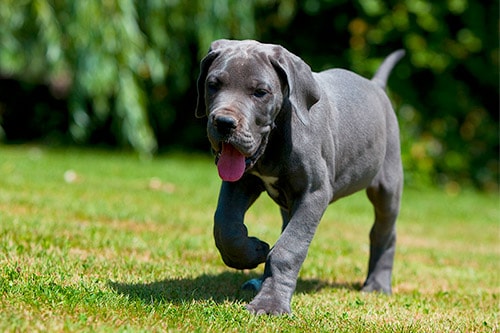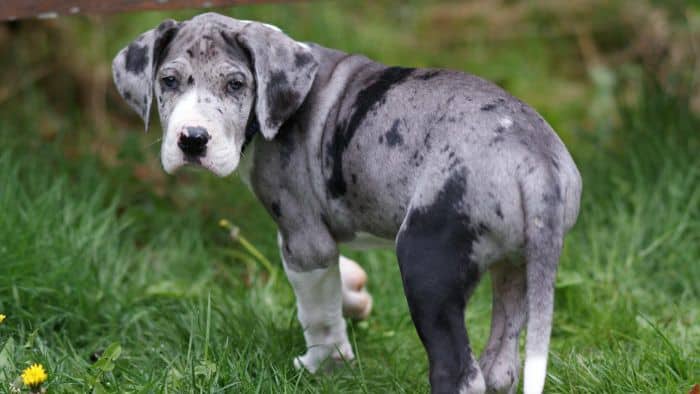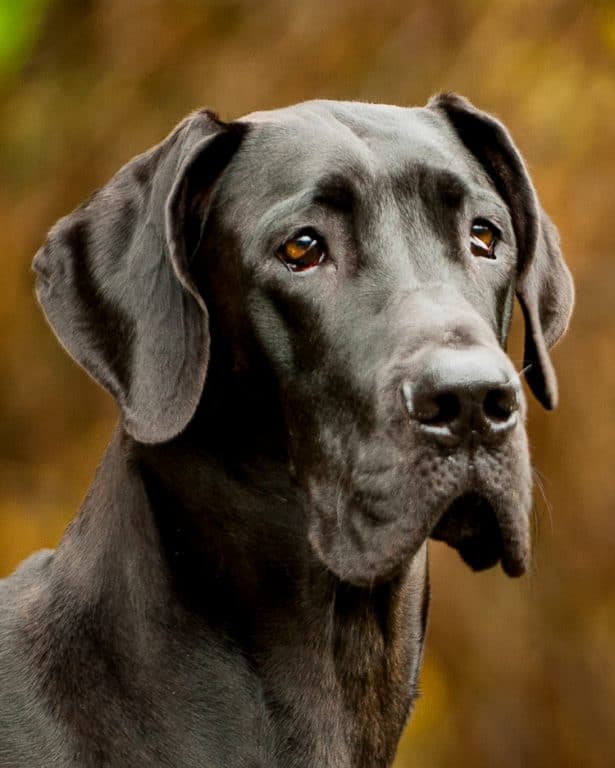
Delve into the striking features that define what Great Danes look like, from their towering stature to their noble expressions. This article unveils the physical traits that set these gentle giants apart, inviting you to explore the breed’s unique beauty.
Great Danes are a tall, lean but muscular, short-coated dog breed that is found in 7 breed standard colors. They feature stately rectangular heads and muzzles, smooth tapering backs, a long tail, and long legs.
Great Danes are often referred to as the “Apollo of dogs,” and their handsome appearance is a large part of the reason why!
Keep reading to find out exactly what these gentle giants are supposed to look like!
Table of Contents
Great Dane Coat
Coat Type
All Great Danes feature a smooth, short coat that lies very close to the body, almost giving them a shaven appearance.
This short coat is a single coat type (unlike the double coat sported by fluffier dogs such as retrievers or collies), and as such, it is very easy to keep a Great Dane’s coat properly groomed.
The most one will need most of the time is a bath now and then.
Even though they only have a single coat, they are still considered light to moderate shedders overall.
For more tips on Great Dane shedding, make sure to bookmark my dedicated article.
While Great Danes can shed their coat all year, they are more likely to shed in spring and summer with the onset of warm weather.
Coat Colors
Great Dane coats might not seem very exciting compared to the looks of some other breeds since their coats are so sleek and short, but when it comes to coat color, they have many more color varieties accepted by international show standards than most other dog breeds.
Take a look at the photos below to take a look at each of the seven approved show colors.
Descriptions of each color can be found in the text below the slideshow.







Each color is described by the Great Dane’s American Kennel Club show standard.
- Black: A black Great Dane must be all black, with no white coloring at all. A black Great Dane, with a spot of white on the chest or paws, is considered mismarked and is disqualified from show.
- Blue: Blue Great Danes are a deep, dark slate gray color all over with a dark nose and eyes. As with black Great Danes, if blue Great Danes possess any white marking or color other than blue, they are considered mismarked for show.
- Fawn: Fawn is one of the most traditional Great Dane colors, and when most people think of a Dane, this is the color they think of. Fawn Great Danes are a light golden color all over except for their faces, which are masked in black.
- Brindle: Brindle is a mixture of browns and blacks in a Great Dane’s coat that almost gives it the appearance of being tiger-striped. Like fawn Great Danes, brindle Great Danes typically feature a black mask over the face and muzzle.
- Harlequin: In a harlequin coat, a Great Dane is predominantly white, but also covered with patches of other colors. A Harlequin Dane is usually patched with black or black and gray.
- Mantle: A Great Dane with mantle coloring is predominantly black, but features a white underbelly, white chest, a white muzzle, a white-tipped tail, and white legs. Mantle Great Danes usually also feature white facial markings such as stars or blazes. Great Danes can have a patch of white in their black mantle or a black break in their white collar and still be eligible for show.
- Merle: Unlike a harlequin Great Dane, which features a white base coat color, merle-coated Great Danes have a gray base coat with darker splotches, patches, and markings over it. Merle Great Danes are also commonly called tri-colored Great Danes.
Along with the standard coat colors accepted by AKC show standards, there are also some non-standard coat colors that are sometimes found in Great Danes.
Here are some other colors you might see that aren’t necessarily allowed in the show ring:
- Mantle color in any color other than black
- Harlequin pattern in any color other than black
- Blue-based brindle (show quality brindle Great Danes must have a brown base coat)
- Blue-masked fawn (show quality fawn Great Danes must have a black mask)
- White
These coat colors can be found in pet quality Great Danes, and having a Great Dane with these looks won’t affect any other aspect of the dog’s disposition unless it is albino, in which case there is a higher likelihood of deafness and other congenital health problems.
If you’re interested in learning more about Great Dane colors, make sure to take a look at our full article here.

Great Dane Musculature
Great Danes are well known for how muscular they are, and their athletic forms play a lot in their overall looks.
Because the Great Dane has a very smooth, short coat, each of its muscles should be very well-defined and visible even at a distance.
While a Great Dane’s muscles are a big part of its look, muscles also play into a Great Dane’s health.
In Great Danes, the heart muscle tends to grow weaker with age due to the heavy load the circulatory system of such a large animal is under on a daily basis, and this cardiomyopathy is one of the contributing factors to their unfortunately short life span in comparison to smaller dogs.
And even though they may still look muscular, older Great Danes can tend to lose muscle in their legs due to inactivity, which can cause them to become wasted-looking and can eventually lead to issues with them being able to stand, especially if they develop arthritis in their senior years.

Great Dane Head Shape
The Great Dane has a very distinguished look, and a lot of this impression comes from the shape of their large heads. Great Dane heads are long and rectangular, with a face reminiscent of a statue.
The Great Dane has a strong forehead and pronounced facial bones, though females of the breed have a smoother, more delicate set to the face and muzzle.
For show, the length of the muzzle from the tip of the nose to the stop (where the muzzle meets the eyes and forehead and angles upward) should be equivalent to the length of the head from the stop to the back of the skull.
Like all dogs, Great Danes have whiskers on their head around their eyes and muzzle that help with their spatial sensory input.
Some people trim their Great Dane’s whiskers for uniformity during show, but the whiskers should never be completely shaved, as this is disorientating to the dog and can cause the dog to move awkwardly.
In extreme cases, it can even lead to temperament problems rooted in spatial disorientation, such as fear-based aggression, according to PetMD.
Great Dane Skull Structure
The bridge of a Great Dane’s nose is very broad, and in show-worthy specimens, the sides of the Great Dane’s skull should be perfectly parallel and symmetrical in comparison.
The Great Dane is known to have a very angular skull, with the male’s skull having more pronounced facial features than the female’s.
Great Dane Muzzles
Other than the teeth inside it, the muzzle of a Great Dane is one of the most intimidating parts of its looks. A Great Dane’s muzzle is deep-set and should be squared off like the rest of its body proportions for proper aesthetics.
In some Great Danes with pet-quality breeding, the upper lip of the dog’s muzzle will hang down and droop over the lower jaw and will “flap” when the dog runs.
This is what is known as a fluttering lip in AKC standards and is seen as an undesirable appearance in a show-quality Great Dane.
Great Dane Teeth
The Great Dane should have a scissors bite, where the top of its bottom incisors dovetail behind and gently touch the bottom of its upper teeth. Great Danes typically have prominent, white, strong-looking teeth in a large long jaw, especially when barking or snarling.
This is one aspect of their looks that made them such impressive estate guard dogs during medieval times. Their teeth also factored into their reputation as hunters of wild boar.
For more details about caring for a Great Dane’s teeth, look at our full guide to dental care here.

Great Dane Nose
A Great Dane’s nose can come in several different colors, depending on the coat color of the Great Dane. Here are some of the colors that show up in Great Dane noses:
- Black: Most Great Dane coat colors come with a black-colored nose as the preferred color.
- Blue-black: Rather than a jet-black nose, blue Great Danes are supposed to have a nose that is a slightly lighter color to parallel their gray coats.
- Spotted nose: Dogs that have a coat with spots or markings, such as merle and harlequin Great Danes, are permitted to have noses that are partially pink with black markings. The only marking that isn’t allowed is a split nose or a nose where half is pink and half is black. This is a disqualification in the show ring.
- Pink nose: Pink noses sometimes show up in different Great Dane coat types with a white base, but they are considered a fault in show. Pink noses on white dogs are particularly looked down on since this is indicative of albinism, which can cause many serious congenital health problems in Great Danes.
Because Great Danes come in so many coat colors, their noses come in almost as many variations.
Great Dane Eyes
Great Danes are supposed to have dark-colored eyes that are medium-sized and set deep in their face. They are known for having tight almond-shaped eyelids that are held tightly against the eyeball.
There are two serious faults associated with Great Dane eyes in the show ring:
- Haw eye: Haw eye, also known as “cherry eye,” is when a Great Dane’s nictitating membrane doesn’t retract all the way and remains visible in the corner of the eye, or when the dog’s lower eyelid hangs downward in a droop, exposing the pink interior of the bottom lid. For more details on this, take a look at my full article on Great Dane cherry eye.
- Mongolian eye: A dog with a Mongolian eye has a round eye that appears deep-set and slanted inside the skull.
In general, it is preferred that Great Danes have dark eyes, at least if they are being exhibited for show. But in lighter colors such as blue Danes, merles, and harlequins, light eyes or blue eyes that are flecked with brown are acceptable according to the breed standard.
One eye color that is particularly undesirable according to the breed standard is yellow, as it is believed that a yellow-colored or light brown eye gives the dog a mean-spirited appearance.


Great Dane Ears
A Great Dane’s ears are one of the most noticeable parts of the breed’s looks since they are traditionally trimmed in such a way that they stand straight up on the dog’s head like vertical flags.
This procedure is called cropping and is typically performed when the dog is still a puppy, and the cartilage of the ear is still malleable.
More often, Great Danes of both show and pet quality are allowed to keep their natural ears, which fold forward down towards the cheeks.
It is important if a Great Dane’s ears are cropped that they are cropped proportional to the dog’s head, as misjudging the proportions during cropping can lead to serious faults in the show ring.
The practice of cropping a Great Dane’s ears goes back 400 years to when Great Danes were used for hunting fierce wild game such as boar. Their ears would often be split and damaged when they brought the razor-tusked boar to bay, so to combat this, medieval lords would crop the dog’s ears.
To learn more about the cropping procedure and different types of cropping, take a look at our guide here.

Great Dane Legs
Great Danes are almost as well-known for their gangly legs as they are for their intense, soulful expressions and their large stature.
The long length of the Great Dane’s legs in proportion to its torso is where the Dane gets most of its height from.
Great Dane puppies grow quickly, and if their dietary needs aren’t properly met during that period of rapid growth, it can lead to defects in the look and function of the legs such as legs that bow forward rather than growing straight up and down.
Luckily this deformed appearance in a Great Dane’s limbs can be rectified through correcting the puppy’s diet, wrapping the legs for added support, and keeping the puppies off slick surfaces until the forming bones can realign properly.

Great Dane Tail
Like the rest of the Great Dane’s coat, the Great Dane’s tail is sleek, and according to breed standards, should lie flat and look like a smooth continuation of the spine.
While the tail may sometimes rise up a bit while the dog is running, the tail shouldn’t be raised up beyond the level of the back.
Some Great Danes may have a curl or ring to the end of their tail shape, and this is considered a serious fault in the show ring.
Unlike many other mastiff-like breeds, Great Danes do not traditionally have their tails docked (removed), and docking a Great Dane’s tail makes it ineligible for show.
Breeders will sometimes dock the tails of puppies they deem to be pet quality, or not up to the breed standard due to cosmetic or medical defects. This docking is done to visually distinguish them from show-quality pups.

Great Dane Size
By far, the most noticeable thing you’ll see when you see a Great Dane is its massive size. The Great Dane is one of the world’s tallest dogs!
Male Great Danes (the larger of the two sexes) can grow to over thirty-six inches tall and even weigh over 200 pounds!
Great Dane females only get a bit smaller at around 28-30 inches and a hundred and forty pounds, but either sex of the dog can easily tower over a human being when it stands on its hind legs.
Because these dogs get so insanely big, it is vital that anyone who decides to adopt or buy a Great Dane is prepared to dedicate plenty of time to properly training it.
While Great Danes naturally have an affable temperament and love to please their masters, it’s important for the human to have control of the Great Dane at all times.
Untrained dogs of any size can be dangerous, but an aggressive dog the size of a Great Dane can easily be lethal to a human, even a healthy and strong adult.
Luckily this same size and the intimidating look it lends the Great Dane is enough to deter most people who might otherwise provoke it into attacking.
Great Danes—An Impressive Dog in the Looks Department!
There are more dog breeds than there are countries in the world, but few leave an impression in the imagination like a Great Dane.
Between their regal bearing and their humongous size, these gentle giants are some of the most striking dogs you’ll ever be lucky enough to see.

Hi zach,
My neighbor has a beautiful 6 month Great Dane in blue merle. Her tail has a thin snake or ribbon running on the tail top back and forth under the skin. I say this marking under the skin too in a cheetah tail in the zoo. Do you know what it is ?